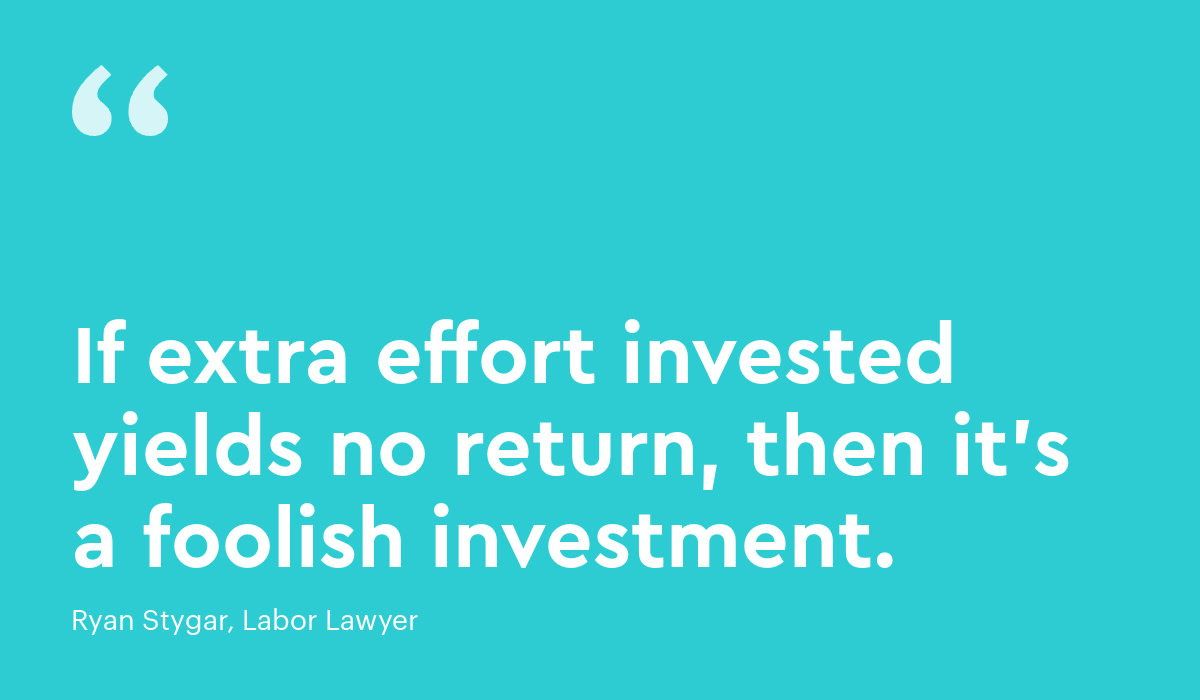Gen Z is Quiet Quitting: Are You Listening?
Quiet quitting is a term for a Gen Z worker phenomenon, where employees are no longer going above and beyond.

Recently the internet has been abuzz thanks to articles in Fortune, HuffPost, USA TODAY and The Wall Street Journal, among others about quiet quitting. Quiet quitting is a term for a Gen Z worker phenomenon, where employees are no longer going above and beyond for their companies. Instead, they do only the work they signed on for, but no more and no less.
This quiet rebellion has emerged post-pandemic as workers prioritize work-life balance. Entrepreneurs, especially those running internet startups, already notorious for a work ethic that recall industrial age sweatshops, are panicking.
These quiet quitters claim they are merely doing the work they are being paid for. While not quitting, they are questioning unpaid overtime and are far less interested in trying to impress their bosses and co-workers or prove themselves. It is a result of the renewed sense of agency felt by workers post pandemic but it is not, as of yet, a worker’s revolt. Whether you agree that workers should have the right to decide what their job should be or not, people managers must begin to pay attention to this phenomenon.
Saying the quiet part out loud
Quiet quitting represents a cultural shift, and is a response to many things—it could be unreasonable expectations, a toxic work culture, a heavy workload, or micro-management. If these issues aren’t acknowledged, addressed, or resolved, the employee may feel they have little choice other than to scale back.
Labor lawyer Ryan Stygar in San Diego, CA isn’t surprised to see this happening. “It’s a logical move by workers. They work for income. If extra effort yields no extra income, then eventually they cease to invest that extra effort at work. It can be frustrating for managers, but they need to recognize that employees are simply reacting to the employer’s own effort/reward systems. If those systems are yielding unwanted outcomes, then they need to be changed.” Putting in more than what’s strictly required can also lead to burnout.
Communication is crucial, especially for remote workers
Quiet quitting can happen when a manager least expects it. If your worker is remote, it is more difficult to track a person’s performance and you may not even know how many hours they’ve actually worked. One way to deal with this is to concentrate more on the quality of the work the employee produces and less on the quantity. If you have an employee who is regularly achieving business outcomes for your company, they shouldn’t have to go beyond the requirements of their job description on a daily basis. At the end of the day, it’s all about communication. Your employees are already feeling cut off from their co-workers. Without communication from the top, they are likely to quit for real this time.
Some workers are quiet quitting without even knowing they are doing it. They still work hard and you might not even be tell that anything has changed. What’s really changed is their attitude toward work. The pandemic caused most people to reevaluate their work life. Many came to the conclusion that work should no longer play an outsized role in their lives.
Shifting work life
In fact, some keen-eyed observers see the outrage over quiet quitting as capitalist propaganda. Just doing your job, if that’s in fact what quiet quitting is, shouldn’t be so controversial. All these workers are really asking for is to be fairly acknowledged for the work they are doing and refusing to do any extra work they aren’t actually being paid for. That this has caused pushback says more about the companies than the employees.
“Quiet quitting is really a misnomer,” says Robert Chan, Senior VP, Head of People Analytics at City National Bank, in Los Angeles. “When doing your job is considered quitting, it just goes to show you that the expectations in the workplace have changed. Post pandemic, the lines have blurred. With remote work you don’t have the physical separation. You are expected to be on all the time.”
Some see quiet quitting as a shift in work-life balance rather than the “checking out” that leadership fears. While these workers may be doing less in their jobs, they are absolutely using the time gained to be more present in their personal lives.
Gen Z is not into ‘workaholic’ anymore
Upon closer examination, there is nothing new about quiet quitting. Awareness of it can be traced back at least as far as the 1999 movie Office Space, where the main character Peter Gibbons works for a soulless corporation. “The thing is, Bob, it’s not that I’m lazy; it’s that I just don’t care—It’s a problem of motivation, alright? Now if I work my ass off and Initech ships a few extra units, I don’t see another dime, so where’s the motivation?,” he says.
Workers are rebelling against the common notion that in order to succeed, one must give 110%. Not only are they looking for more work-life balance so that they can spend time with their families or pursue hobbies outside of work, these workers have decided that they have had enough of our workaholic culture. Rather than view this as something sinister, leadership should see this as healthy. Quiet quitting may even be good for your employee’s mental health. The key is listening to your employees and understanding how they feel about their work. Empathy can go a long way here. Gen Z has faced the brunt of the changes brought on by the pandemic. To hear from Gen Z directly, just search TikTok for hashtag #quietquitting.
Renegotiation of work responsibilities
Work responsibilities have always been the product of negotiation. Since most quiet quitting is about doing the job exactly as described, people managers can sidestep any major issues by making sure the job is adequately described. This starts with the job description, but it should be reinforced in regular communication. Some managers ask their employees to give them a sense of what they are working on, on either a daily or weekly basis, depending on the type of job. Workers get it. You’re busy. But letting them know your preferred means of communication, whether that be email, text, Slack, or other can help when work is being done remotely or when you don’t have as much face time as you’d like with your employee.
Onboarding is an important time to explain not just the responsibilities of the position to your employee, but also the expectations. It is also a good time to determine objectives and key results (OKRs) and to discuss how your new employee’s performance will be measured. What will the job look like on a day to day basis? Will there be regular 1:1 meetings, standups, or other kinds of check-ins so the employee knows whether they are doing the job they signed on for? Many hiring managers ignore these crucial steps. People managers should insist on these meetings. Determining all of these things upfront can help stave off quiet quitting.
Gen Z: Where the rebellion’s at
If there is an epicenter for this rebellion, it’s TikTok, where Gen Z regularly posts short confessional videos about their jobs. While this can devolve into fruitless complaining (it’s the Internet, after all) TikTok can provide some insight into quiet quitting for people managers trying to make sense of it all. Many Gen Z employees got their first jobs during the COVID-19 pandemic and have never known anything other than a world where work, school, and home life blurs into one. In addition, Gen Z is dealing with the unprecedented stress of inflation, low wages, competition with AI, supply shortages, and just plain having to stay alive. “Its not that they are lazy,” says Stygar. “They are exceptionally passionate and creative. They also have an almost supernatural ability to command technology in a way that cuts costs and improves our productivity.”
So instead of viewing Gen Z as somehow defective, Stygar suggests that employers find a way to reward them when they show the kind of initiative he describes. Bonuses are always welcome of course but there are other things they value.
Is ‘quiet quitting’ just giving up?
Arianna Huffington, founder and CEO of Thrive Global, which makes a product suite designed to promote employee wellness and combat burnout has a different take. Posting on LinkedIn recently, she sees quiet quitting as the first step to giving up on life itself. While that’s overly dramatic, if quiet quitters are just “going through the motions,” as she suggests, it may be time for them to reevaluate what they need from their work life. “Work can give us meaning and purpose,” she says. “We should absolutely reject “hustle culture and burnout. But rejecting burnout doesn’t mean rejecting the possibility of finding joy in our work.”

Huffington proposes “joyful joining” instead. Quiet quitting may be a bellwether for better things to come. But if Huffington’s view sounds elitist to you, you aren’t alone. It’s hard to imagine the TikTok crowd embracing “joyful joining.” For one thing, it is probably too late to propose this as a solution. They may already be too burned out to seek more inspiring employment.
Generational differences
This reflects a generational shift in attitudes toward work. Huffington’s generation built its careers at a time of economic optimism. In her America, putting in extra overtime, effort, or training would result in a tangible return—in the form of a raise or a promotion. Boomers like her see a direct correlation between hard work and success.
For Millennials and Gen Z, however, it is a very different story. Labor unions have less power, and pensions are no longer the sacred cows they used to be. Gen Z isn’t even sure it can rely on social security. Even the Payroll Protection Program enacted during COVID-19 succumbed to the greed of businesses who pocketed the cash while workers struggled. Add to that the impact of climate change, the war in Ukraine, and rising inflation, and it’s no wonder that Gen Z is reconsidering its lifestyle choices. All of these things have given it the jitters. Many no longer think in terms of 30 year careers. Job loyalty is at an all time low—and for good reason.
While the Boomers were able to buy houses, build retirement funds, and receive rewards such as pensions, company health plans, and promotions, the same has not been true for Gen Z. For the first time in recent memory, wages are not keeping up with inflation. “It’s not a protest; it’s a rational calculation. If extra effort invested yields no return, then it’s a foolish investment,” says Styger.

Listen to your employees
According to a report from Deloitte, 95% of C-suite executives agree they should be responsible for employee well-being, and 83% say they are making the changes necessary to improve employee well-being. Leadership fears a lack of engagement but with the right listening tools, you should be able to heed the warning signs that lead to burnout, dissatisfaction, and frustration. Managers should check in regularly with their employees to make sure they are still enjoying their jobs and moving forward in their careers.
Stygar proposes leadership take the following steps:
Look at your job descriptions to make sure they accurately and fairly describe the requested work. If not, redo them.
Ask why an employee should be motivated to go above and beyond. Just expecting that they subscribe to your notion of a “work ethic” is not enough. Your employees don’t owe you anything other than what they are being paid for.
Retool your reward system so that it is more in sync with contemporary expectations. Recognize that all effort expended by employees is an investment. There are many ways to reward hard work, from a fair paycheck and a bonus structure to treating them as an important, accepted, and celebrated member of the team.
Follow Google’s lead and establish agreed upon and measurable OKRs.
Go above and beyond for your employees rather than expecting them to do the same for you. If they know you have their best interests in mind, they are more likely to do the same for you.

Learn more about Gen Z in the workplace in Visier’s report, What Gen Z Workers Really Want.
Get the Outsmart newsletter
You can unsubscribe at any time. For more information, check out Visier's Privacy Statement.


